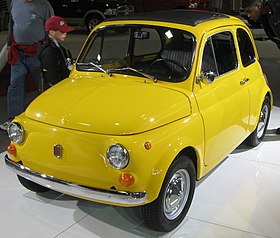Fiat 500
| Fiat 500 | |
|---|---|

1970 Fiat 500
|
|
| Overview | |
| Manufacturer | Fiat |
| Production | 1957–1975 3,893,294 units |
| Assembly |
|
| Designer | Dante Giacosa |
| Body and chassis | |
| Class | City car (A) |
| Body style |
|
| Layout | Rear-engine, rear-wheel drive |
| Related | |
| Powertrain | |
| Engine |
|
| Transmission | 4-speed manual |
| Dimensions | |
| Wheelbase | 1.84 m (72.4 in) |
| Length | 2.97 m (116.9 in) |
| Width | 1.32 m (52.0 in) |
| Height | 1.32 m (52.0 in) |
| Kerb weight | 499 kg (1,100 lb) |
| Chronology | |
| Predecessor | Fiat 500 "Topolino" |
| Successor | Fiat 126 |
The Fiat 500 (Italian: Cinquecento, Italian pronunciation: [ˌtʃiŋkweˈtʃɛnto]) is a rear-engine two-door, four passenger city car manufactured and marketed by Fiat Automobiles from 1957 to 1975 over a single generation in coupé and station wagon bodystyles.
Launched as the Nuova (new) 500 in July 1957, it was a cheap and practical town car. Measuring 2.97 metres (9 feet 9 inches) long, and originally powered by a 479 cc two-cylinder, air-cooled engine, the 500 is considered one of the first city cars.
In 2007, the 50th anniversary of the Nuova 500's launch, Fiat launched another new 500, stylistically inspired by the 1957 Nuova 500, featuring a front-mounted engine and front-wheel drive.
To meet the demands of the post-war market which called for economy cars, in 1949 a front engine Fiat 500 was released. It had a 2-door coupe body with sun-roof, which was later complemented by an Estate version. Both continued until 1954 when they were replaced by an all-new, lighter car. The new car had a rear-mounted engine, on the pattern of the Volkswagen Beetle, just like its bigger brother the 1955 Fiat 600. Several car makers followed the now uncommon rear engine configuration at the time and were quite successful. The Neckar version of the 500 was manufactured in Heilbronn under a complicated deal involving NSU, and was introduced in October 1961.Steyr-Puch produced cars based on the Fiat 500 under license in Graz, Austria.
Despite its diminutive size, the 500 proved to be an enormously practical and popular vehicle throughout Europe. Besides the two-door coupé, it was also available as the "Giardiniera" estate; this variant featured the standard engine laid on its side, the wheelbase lengthened by 10 cm (3.9 in) to provide a more convenient rear seat, a full-length sunroof, and larger brakes from the Fiat 600.
...
Wikipedia
